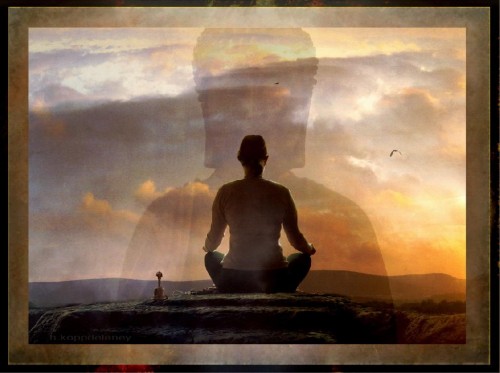The 10-day Vipassana meditation course I recently completed reminds me of a personal commitment similar to that of climbing a challenging mountain—not the physical intensity, but a parallel level of introspection and perseverance.
The retreat was in the tradition of Sayagyi u Ba Khin, and has been carried on for years by S. N. Goenka.
I just felt I had to go.
I didn’t want to skate across the surface of my thoughts for the rest of my life; I wanted to try to uncover the unconscious pockets—to look into the crevasses of my mind to see what’s there to find.
In the four months leading up to this retreat, I had worked to develop a meditation practice, but had not yet sat in that space for longer than an hour.
The first day was difficult.
It wasn’t hard for me to rise at 4 a.m., but I was challenged by the two-hour group meditation from 4:30 to 6:30 a.m.
Normally, I can hardly sit for a few minutes, let alone for two hours. I was trying to stay present and focus on the simple mantra:
“This too will pass.”
This first session was only the beginning, and what was to come was a long, life-changing journey.
Eventually, Vipassana meditation is meant to lead to insight into the impermanence of all phenomenon, and thereby leads to permanent liberation.
Daily Practices
The retreat was held in Menomonie, Wisconsin, in a turn-of-the-century estate with many acres to stroll and ponder.
Movement around the area is limited in the winter months to snow-cleared walking paths, but nice nevertheless.
We all arrived on a Wednesday afternoon in January.
There were about 18 men and approximately the same number of women in attendance. We were individually assigned to the main house or an annex building.
My area was about eight feet by 10 feet, with a basic single bed and decently firm mattress. A rack for luggage and a folding steel chair were included.
Daily breakfast followed the early morning meditation at 6:30 a.m.
Oatmeal for 10 days straight is not exciting. It was steel cut and tasty, but oatmeal just the same.
As the days went on, I dreamed of other foods— beef tacos, cheese enchiladas and chocolate.
“Please stop the cravings, thank you.”
But they came, just the same.
Every day’s early morning, mid-morning meditation, lunch and afternoon meditation arrived consistently, followed by a tea and fruit break at 4 p.m.
The tea was kept in a large pot, meant to be ladled into your cup. Bananas, oranges and nice local apples accompanied the steeped herbs.
More meditation followed; it was a taped course by Goenka. This was my favorite part of the day.
Lights out at 9:30 p.m.
“The Core Of The Unconscious Brain.”
Systematic practice eventually eliminates the cause of mental and physical pain, purifies the mind and results in a stable happiness that isn’t affected by moods or outward circumstances.
Ten hours a day in a meditation position, however, was trying to say the least.
By the fourth day, we were all expected to hold a seated position, with closed eyes, and no feet or hand movement.
Goenka started teaching Vipassana Meditation in India in 1969. His teacher was Sayagyi U Ba Khin, who passed in 1971. Over the years the teaching has spread worldwide and throughout the U.S.
During the 10 days, repetition was a predominant method used. This tool was meant to help all students get a handle on this meditation technique.
Through meditation, Goenka said, we can go to the core of the unconscious brain, to then root out deep seated cravings and aversions.
It’s like removing puss from a brain infection, then allowing the healing process to begin. When we only operate on the surface level of the brain, the sporadic ups and downs paralyze the ability to handle daily stress.
If you don’t believe me, try the course. It’s free and worldwide.
You can make a donation after completion, but you are only asked to give what is the right amount for you, in funds or in future service. They certainly don’t encourage you to divide the total cost of the week for the site and food (a cost of approximately $25,000) for the week.
Inspiring Awareness
I have to mention a special “old student,” who impressed me at this site. “Old” means he has taken at least one 10-day course. In his case, he has completed four 10-day sessions over the years—one in Nepal.
He is still a young man. I like to call him the “Terminator Meditator,” characterized by black shades, a black cap and a ponytail.
He could sit for four hours without movement. I approached him after the silence was broken on the tenth day, and I told him that I was impressed with his long sittings. He said that when he reaches a Panna State, he feels the need to keep going and not break this meditation.
Panna is defined as insight in the true nature of reality.
Upon completion of these 10 days, I am now an “old student” myself.
It was suggested that we follow up once a year with a 10-day course or a weekend course, or to do an act in a service capacity at one of the meditation sites, anywhere in the world.
If the practice is continued, Vipassana Meditation is a wonderful technique and acts as a “shock absorber” to life’s daily ups and downs.
I think another positive aspect of the course is that it is non-sectarian and does not promote any religion. It could, however, easily work along side any religion, and is meant to help you as a human being.
The 10 days is over, but it is up to me to develop my own salvation. I am on the path and walking in the direction that is right for me.
The work now is to continue to keep up this new level of awareness. I find myself less interested in the radio, talk shows, news and TV.
It is all a distraction to a daily life that is enriched by living in the present with joy.
There is just so much out there, and yet we dilute it.
Do you want to be entertained the rest of your life, or do you want to study something and improve your mind?
Vipassana has the capacity to transform the human mind and character. The opportunity awaits all who sincerely wish to make the effort.
It is easier to not commit, and to not complete, this 10-day experience. Easy, however, is not the path I recommend. I feel now that there is no place I don’t want to go; nothing I don’t want to experience.
This meditator is no longer reluctant, and has embraced meditation.
Relephant:
What I Learned after 10 Days in Silent Meditation.
~
Author: Alan Fuller
Apprentice Editor: Brandie Smith/Editor: Travis May
Photo: Hartwig HKD/Flickr
~
Facebook is in talks with major corporate media about pulling their content into FB, leaving other sites to wither or pay up if we want to connect with you, our readers. Want to stay connected before the curtain drops? Get our curated, quality newsletters:












Read 1 comment and reply